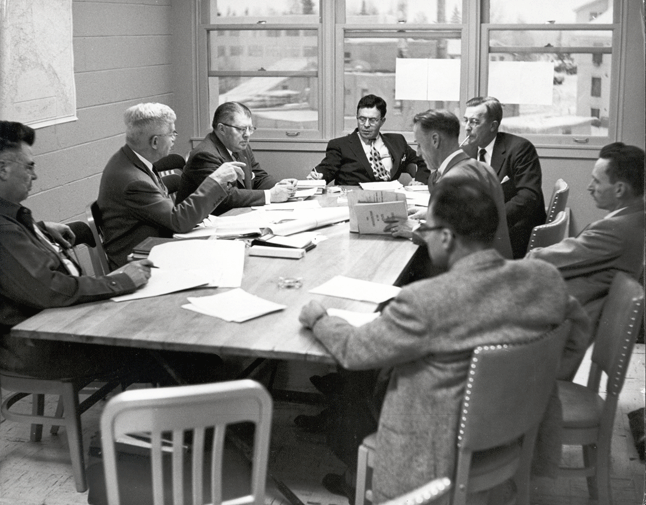
When the framers of Alaska’s constitution were debating how the state should pick its judges, the goal was to remove politics from the process as much as possible.
In territorial days, judges were political appointees named by the president of the United States, said Matt Peterson, an Anchorage attorney who’s teaching a seminar on the Alaska Constitution.
“There was a wide variety of competence amongst the political appointees,” he said. “And the idea was to have a system of what we would call merit selection, where people were decided on the basis of competence, integrity, fairness — and not on political considerations.”
Under the current system, an independent commission called the Alaska Judicial Council vets applicants and selects a pool of potential judges that is presented to the governor, who picks one to fill a judicial vacancy. The council is made up of three attorneys and three members of the public. The chief justice of the Alaska Supreme Court serves as chair of the council and can provide a tie-breaking vote.
Twenty-six states, including Alaska, use this type of appointment process.
But Jim Minnery, executive director of the Alaska Family Council, a conservative Christian advocacy group, said the system we ended up with missed the mark.
“All it does, really, is just move the politics behind closed doors,” he said.
Minnery is backing efforts to pass Ballot Measure 1, which would set another constitutional convention in motion. A chance to rewrite the judicial selection process is one of the main reasons he’s pushing for a convention.
Minnery, and other opponents of the current process, claim that the attorney members of the council skew liberal and have propagated a judiciary that leans to the left.
“They do a very strong vetting process. And if they do not match the liberal members — the attorney side of the Judicial Council — the governor’s not going to see those people,” he said.
Minnery points to Alaska Supreme Court rulings protecting abortion rights in recent decades that he argues are a result of the current selection process. In 1997 the court found Alaskans’ right to abortion is protected under a constitutional right to privacy. In 2020, a Superior Court judge found that Gov. Mike Dunleavy’s attempts to pull state funding from the Supreme Court over abortion rulings unconstitutional.
“I think it’s a usurpation of their power, manufacturing things that don’t exist and making law from the bench as opposed to interpreting the Constitution,” he said.
Minnery said he’d prefer to see a process that skips the council and allows the governor to appoint their pick.
According to minutes from the original convention, delegates did consider this appointment method. They also considered the possibility of electing judges. Both were ruled out on the basis that they would subject judicial candidates to partisan politics.
A consultant’s report commissioned by the original delegates did raise concern that Alaskans wouldn’t have enough say in the process and suggested adding a fourth seat for a non-attorney member of the public. According to Peterson, that idea was debated in the judiciary committee of the convention and eventually rejected.
Elaine Andrews, a retired Alaska superior and district court judge, said it makes sense to have input from the legal community when selecting judicial candidates, because, she said, lawyers know lawyers best.
“Lawyers see each other operate, they work on opposite sides from each other. They know whether a person is ethical, respectful, capable, hard-working, all those things,” she said.
But even as a proponent of the Judicial Council, Andrews admits the current process isn’t perfect.
“I think people would be naive to say there’s no politics in it,” she said. “The governor can choose an applicant that the governor feels most comfortable with politically. But the citizens of Alaska can be assured that the governor’s choice is someone who is qualified for the position — and not only qualified, but among the most qualified of the applicants.”
Andrews was appointed a District Court judge in 1981 by Gov. Jay Hammond, and a Superior Court judge in 1991 by Gov. Walter Hickel. After both appointments, she said she had to go up and introduce herself to each governor, because they’d never met before.
“That’s a pretty clear sign of, in my experience, how apolitical things were,” she said.
Andrews rejects the notion that the council skews liberal in its decision-making. The majority of Alaska Bar Association members are nonpartisan or undeclared, according to a study Alaska Family Council paid for in 2020.
Since 1984, the judicial council has voted unanimously, or close to it, 83% of the time, according to council executive director Susanne DiPietro. In the last five years the chief justice has only had to cast a tie-breaking vote seven times, out of 246 votes. Retention votes, which happen periodically to determine whether judges should remain on the bench, are nearly always unanimous, she said.
Republican former state senator John Coghill, whose father was an original delegate to the convention in 1955, said the judicial council is a “noble” idea for selecting judges, but he agreed with Minnery and other conservatives who want to see their ideas better represented in the process.
“On judicial selection, generally speaking, they have my heart on the matter,” Coghill said. “But do I think that they can change that in the political dynamic that we’re in, in Alaska? I just don’t think so.”
Coghill said adding more non-attorney seats to the council, like the consultant’s report suggested, could be one way to address that concern — but he doesn’t think it’s worth an entire constitutional convention.



